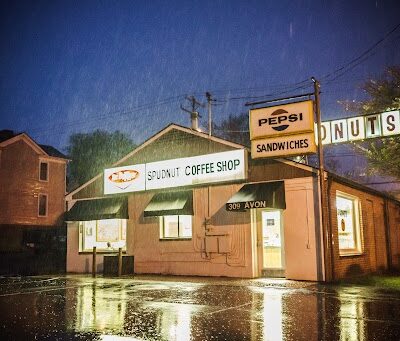Gail Hobbs-Page, who is an activist for small farms and a vocal proponent of local food —the “Vote with your Fork” section of the CaroMont Farm website and blog links you straight to government officials on the topics of small farm agriculture—is a great spokesperson for the movement. As a trained chef (most recently at Hamiltons’, The Mark Addy Inn and Feast!), she can speak to the finer aspects of farm-to-table. As a former farm girl from North Carolina whose family tended to peanuts and tobacco as well as crops and livestock for its own sustenance, she knows what it is to live off the land—“We didn’t go to the store very often,” says Hobbs-Page. And finally, as a goat farmer and cheese maker, she has, hands down, the cutest mascots: a mixed herd of Nubian, La Mancha and Alpine goat breeds with pet names such as Cappuccino and Mandella who live very happily and healthfully in what she calls her “Go-Tel.”
|
This Alpine breed is one of Hobbs-Page’s smiling-happy “Go-tel” residents. |
With the goats bleating, the Great Pyrenees guard dog wagging his tail nearby and 15 acres of quintessential Central Virginia vista spreading out from the contemporary timber-framed home Hobbs-Page shares with her husband, Hamiltons’ manager Daniel Page, it’s all very idyllic and photogenic. The folks at Southern Living magazine thought so. They did a spread on CaroMont (as well as several other local farms including Roundabout, which we feature here), in their July issue. After publication, Hobbs-Page’s phone began to ring off the hook with “little old ladies from Richmond, asking ‘May we visit your fahm?’” she says in her best impression of a genteel Southern accent.
CaroMont is very fetching and thus ripe for agritourism, but it’s also serious business for Hobbs-Page and less than fit for the faint of heart when you consider all the difficult details of a goat farming and cheese making operation. Breeding and tending farm animals is messy work after all. There’s the twice-a-day milking, the on-the-fly-learning of “goat medicine,” the thinking two seasons ahead on how you’re going to feed all those hungry goats. Then there’s the process of separating the kids from the moms (so you can get the milk), the hard decision of which to keep each breeding season and the even harder decision of what to do with those you can’t keep. A hide tanning in the sun in her open shed—a side project of her college student summer intern—is one telltale sign that not all the goats get a ticket to the Go-Tel forever.
“We sell some to people we believe (and hope) are keeping them for foundation herds,” says Hobbs-Page. But there is the occasional transaction involving goats for meat. “It is heartbreaking,” says Hobbs-Page, “but it’s a decision that you have to make.”
Then there are the government inspections, the crippling proposed legislation—the USDA’s pending National Animal Identification System could be financially disastrous for small farms such as CaroMont. Add to that the grinding details of packaging, selling and distributing a perishable product for profit. Hobbs-Page’s tiny office next to the walk-in cheese cooler is littered with labels, boxes and FedEx stickers. She currently has 79 local and regional accounts for one or more of her five varieties of chevre, from restaurants such as The Local, to retail outfits such as Feast! and Horse & Buggy, and the list is growing. She’ll produce 6,000 pounds of cheese this year. In 2004, her first year, it was 1,500.
Growth has been swift, but Hobbs-Page says after five years, she’s only just getting started honing her own skills: “Now, I’m finally getting into the cheesemaking,” says the former professional chef, who says, “I love the expression of food from milk.”
|
Soft cheeses such as chevre yield best to the right knife. $8 from The Happy Cook. |
Beet salad with goat cheese
From Matthew Hart, executive chef of The Local
8 medium red beets
1 1/2 cups fresh CaroMont Farm goat cheese
3/4 cup sour cream
2 Tbs. cornichons finely chopped
2 Tbs. capers
1/4 cup parsley, finely chopped
2 Tbs. shallot, finely diced
Salt and pepper
Aged sherry vinegar to taste
Olive oil
Planet Earth Diversified microgreens for garnish
Beet vinaigrette (go to c-ville.com for recipe) or other boldly flavored vinaigrette
Preheat oven to 350 degrees. Wash beets under cold water. Toss with olive oil and season with salt and pepper. Wrap beets in foil and cook in oven for approximately 45 minutes (beets are done when the tip of a pairing knife pierces the middle of the beet with no resistance). When cool enough to handle, peel beets (rub them with a paper towel between your hands) and finely dice them. Combine beets with the remaining ingredients and mix thoroughly. Let the mixture cool and adjust seasoning with salt, pepper, sherry vinegar and more sour cream if necessary.
Mound salad mixture in the middle of a plate. Top with microgreens and spoon vinaigrette around the plate. Hart says: “If you are feeling ‘cheffy’ and want to really push the presentation over the top then use a ring mold or tomato paste can with both ends cut off to mound your beets into a perfect cylinder.” Makes a first course or side dish. Serves 6.
Beet vinaigrette
4 medium red beets
1 cup red wine vinegar
2 cups water
1 ½ cups extra virgin olive oil
Salt
Wash and roughly chop beets. Combine with water, vinegar and a pinch of salt. Cook over medium heat until liquid is reduced by two-thirds. Strain and let cool. Stir in extra virgin olive oil. Do not try to emulsify.
 |
VIVE LA CHEVRE!
If you’re wondering who produces the most goat cheese, it’s France of course. Most dairy goats hail from south of the Loire Valley. And yes, cheese does have terroir.
Back to FOOD & DRINK 2009 ANNUAL







